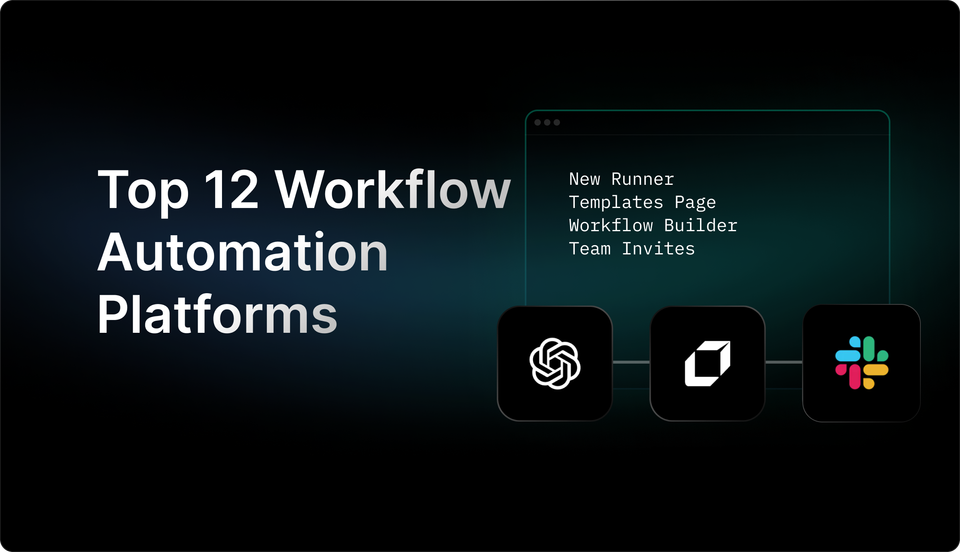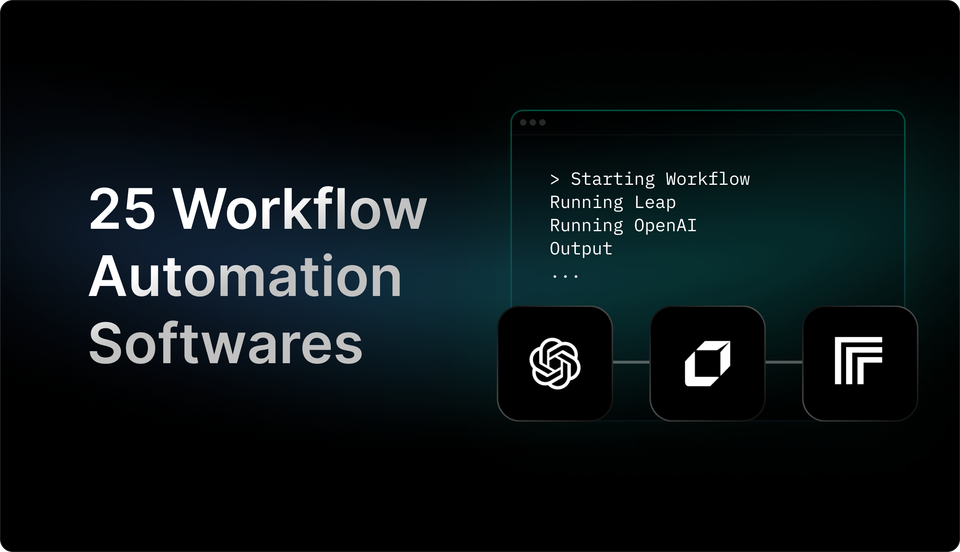Complete Guide On Workflow Automation vs RPA In 2024
Streamline processes with Workflow Automation vs RPA. Boost efficiency, cut costs, and choose the right solution for seamless business operations

Explore the key distinctions between Workflow Automation and RPA (Robotic Process Automation) in this insightful blog. Delving into the efficiency and operational improvements brought by Workflow Automation vs RPA, we uncover the nuances of how each streamlines processes differently. Discover the power of Workflow Automation in enhancing productivity and the unique capabilities of RPA in automating repetitive tasks for optimized business performance. Dive into this comparative analysis to unlock the potential of Workflow Automation vs RPA for your organization's success.

What Is Workflow Automation Vs RPA?

Workflow automation involves defining, executing, and managing a series of tasks or processes to achieve a specific outcome within an organization. It focuses on streamlining routine tasks, improving efficiency, and reducing human error by automating manual processes. Workflow automation tools often use visual interfaces or drag-and-drop functionalities to design and implement automated workflows, making it accessible to users with varying technical skills.
RPA, on the other hand, uses software robots or bots to automate repetitive, rule-based tasks typically performed by humans. These bots interact with existing systems through user interfaces to execute tasks such as data entry, data extraction, form filling, and more. RPA is especially useful for tasks that involve structured data and are prone to human error, enabling organizations to increase productivity and accuracy while freeing up employees to focus on higher-value activities.
Leap Helps You Automate Your Work with AI Workflows
Leap helps you to automate your work with the power of AI. Partnered with Zapier, Vercel, and more, Leap enables you to supercharge your work by allowing you to create custom AI automations. Create sophisticated AI automations with no-code. Connect the tools you love with best-in-class AI text, image, and audio models.
Supercharge your existing tools with seamless AI integrations to OpenAI, Microsoft, and more. From summarizing documents, to voice translation, to AI call transcription, to AI avatar and asset generation, to SEO automation, automate anything with Leap Workflows. The opportunities for automation are endless with Leap workflows.
Try Leap’s AI Workflows tool for free today.

Related Reading
Benefits of Workflow Automation Vs RPA

Workflow Automation Benefits
Workflow automation streamlines business processes by automating repetitive tasks, reducing human errors, and improving overall efficiency. By implementing workflow automation tools, businesses can create standardized processes, ensuring consistency and compliance. This results in increased productivity and faster task completion times, leading to enhanced operational efficiency.
Workflow automation enables better visibility and tracking of tasks, as it provides real-time insights into the status of each process. This transparency allows for better decision-making and resource allocation. Workflow automation fosters collaboration among team members, as it facilitates seamless communication and task assignment, resulting in improved teamwork and project management.
RPA Benefits
Robotic Process Automation (RPA) takes automation a step further by mimicking human actions to perform rule-based tasks. RPA software can handle repetitive tasks that require data manipulation, transactions, and communication across multiple systems. This accelerates process execution, reduces manual intervention, and minimizes errors, leading to improved accuracy and cost savings.
RPA also enhances scalability and agility within organizations, as it can be easily scaled to accommodate fluctuating workloads. By automating routine tasks, employees can focus on more strategic and value-added activities, fostering innovation and creativity within the workforce. RPA integrates with existing systems and applications, allowing for seamless automation across different platforms.
Leap AI Workflows
Leap helps you to automate your work with the power of AI. Partnered with Zapier, Vercel, and more, Leap enables you to supercharge your work by allowing you to create custom AI automations. Create sophisticated AI automations with no-code. Connect the tools you love with best-in-class AI text, image, and audio models.
Supercharge your existing tools with seamless AI integrations to OpenAI, Microsoft, and more. From summarizing documents, to voice translation, to AI call transcription, to AI avatar and asset generation, to SEO automation, automate anything with Leap Workflows. The opportunities for automation are endless with Leap workflows.
Try Leap’s AI Workflows tool for free today.
How Can Workflow Automation and RPA Work Together

The seamless integration of Workflow Automation and Robotic Process Automation (RPA) technologies can revolutionize how businesses operate. Workflow automation acts as the backbone, providing the structure and framework to manage complex processes efficiently. It allows organizations to map out, streamline, and optimize their workflows, ensuring tasks are sequenced correctly and progress smoothly from one stage to the next.
On the other hand, RPA focuses on automating specific tasks within these workflows, handling repetitive and rule-based activities that would otherwise be performed manually. By combining Workflow Automation with RPA, businesses can achieve a synergistic effect where individual tasks are automated by RPA bots within the overarching structure provided by workflow automation.
Enhancing Workflow Efficiency
The collaboration between Workflow Automation and RPA leads to significant improvements in workflow efficiency. Workflow automation ensures that the entire process is well-organized and orchestrated, while RPA steps in to automate mundane, repetitive tasks with precision and speed. This combined approach eliminates bottlenecks, reduces errors, and accelerates the completion of tasks, resulting in enhanced overall workflow efficiency.
Increased Productivity and Reduced Errors
By leveraging the strengths of both Workflow Automation and RPA, organizations can boost productivity levels significantly. Workflow automation sets the stage by defining the workflow logic and sequence, while RPA takes care of executing tasks without human intervention. This combination not only speeds up processes but also minimizes the chances of errors, leading to higher productivity and improved outcomes.
Compliance and Operational Efficiency
The integration of Workflow Automation and RPA also contributes to enhanced compliance and operational efficiency. Workflow automation ensures that processes adhere to regulatory requirements and internal policies, while RPA enforces consistency and accuracy in task execution. This dual approach not only reduces the risk of non-compliance but also enhances overall operational efficiency by automating tasks that are prone to human error.
The Versatility of AI Automation with Leap Workflows
Leap helps you to automate your work with the power of AI. Partnered with Zapier, Vercel, and more, Leap enables you to supercharge your work by allowing you to create custom AI automations. Create sophisticated AI automations with no-code. Connect the tools you love with best-in-class AI text, image, and audio models.
Supercharge your existing tools with seamless AI integrations to OpenAI, Microsoft, and more. From summarizing documents, to voice translation, to AI call transcription, to AI avatar and asset generation, to SEO automation, automate anything with Leap Workflows. The opportunities for automation are endless with Leap workflows.
Try Leap’s AI Workflows tool for free today.
Related Reading
- Accounts Payable Workflow Automation
- Business Automation Workflow
- Crm Workflow Automation
- Document Workflow Automation
- Education Workflow Automation
- Email Workflow Automation
- Enterprise Workflow Automation
- Hr Workflow Automation
- Intelligent Workflow Automation
- Marketing Automation Workflow Examples
- Legal Workflow Automation
- Small Business Workflow Automation
- Workflow Process Automation
- Ai Workflow Automation
How To Choose Between Workflow Automation vs RPA

When considering whether to choose Workflow Automation or Robotic Process Automation (RPA), it is essential to understand the core differences between the two. Workflow Automation focuses on streamlining and optimizing business processes by automating repetitive tasks and improving collaboration between team members. On the other hand, RPA involves automating repetitive, rule-based tasks using software robots or AI to mimic human interactions with digital systems.
Complexity of Processes
For businesses with complex and non-linear processes that require human decision-making and judgment, Workflow Automation is typically more suitable. Workflow Automation allows for the orchestration of tasks across different systems and departments, ensuring a seamless flow of work. On the other hand, RPA is best suited for businesses with highly repetitive, rule-based processes that do not require human intervention, such as data entry, form filling, or data extraction.
Integration Capabilities
When it comes to integrating with existing systems and applications, Workflow Automation shines. It can easily connect disparate systems, databases, and tools to create end-to-end processes. In contrast, RPA may face challenges when integrating with legacy systems or applications that lack APIs, as it relies on the user interface to interact with systems.
Scalability and Flexibility
Businesses looking for scalability and flexibility in their automation approach may find Workflow Automation more suitable. Workflow Automation platforms often offer a wide range of customization options, allowing businesses to adapt processes as needed. RPA, while powerful for repetitive tasks, may require more effort to scale and maintain as processes evolve.
Decision-Making and Cognitive Abilities
If your business processes require decision-making, cognitive abilities, or handling unstructured data, Workflow Automation will be the better choice. Workflow Automation platforms can incorporate decision trees, conditional logic, and human intervention points within processes. In contrast, RPA is more effective for tasks that follow predefined rules and structured data.
Unlimited Possibilities with Leap AI Automation
Leap helps you to automate your work with the power of AI. Partnered with Zapier, Vercel, and more, Leap enables you to supercharge your work by allowing you to create custom AI automations. Create sophisticated AI automations with no-code. Connect the tools you love with best-in-class AI text, image, and audio models.
Supercharge your existing tools with seamless AI integrations to OpenAI, Microsoft, and more. From summarizing documents, to voice translation, to AI call transcription, to AI avatar and asset generation, to SEO automation, automate anything with Leap Workflows. The opportunities for automation are endless with Leap workflows.
Try Leap’s AI Workflows tool for free today.
12 Tips On Implementing Workflow Automation Vs RPA

Implementing Workflow Automation
1. Understand Your Processes
Before implementing workflow automation, thoroughly understand your existing processes to identify areas for improvement and automation.
2. Set Clear Objectives
Define clear objectives for automation, such as reducing manual tasks, improving efficiency, or enhancing accuracy, to guide your implementation strategy.
3. Involve Stakeholders
Engage key stakeholders from different departments to gather insights, requirements, and feedback to ensure successful automation implementation.
4. Choose the Right Tools
Select workflow automation tools that align with your business needs, scalability, and integration capabilities to maximize efficiency.
5. Design User-Friendly Workflows
Create intuitive workflows that are easy to understand, navigate, and use by employees at all levels to encourage adoption and maximize benefits.
6. Provide Adequate Training
Offer comprehensive training sessions to equip employees with the necessary skills and knowledge to effectively utilize the automated workflows.
7. Monitor Performance
Continuously monitor the performance of automated workflows, collect data, and analyze metrics to identify areas for optimization and further automation.
8. Iterate and Improve
Regularly review and refine your automated workflows based on feedback, performance data, and changing business requirements to ensure continued success.
9. Ensure Security and Compliance
Implement robust security measures and ensure compliance with relevant regulations to protect sensitive data processed through automated workflows.
10. Encourage Feedback
Create channels for employees to provide feedback on automated workflows, suggest improvements, and report any issues for timely resolution.
11. Scale Gradually
Start small with automation implementations, pilot projects, or specific processes, and gradually scale up based on success, learnings, and organizational readiness.
12. Celebrate Success
Acknowledge and celebrate the achievements, efficiencies, and benefits brought about by workflow automation to motivate employees and foster a culture of innovation.
Implementing RPA
1. Identify Repetitive Tasks
Identify high-volume, rule-based, and repetitive tasks within your processes that are ideal candidates for RPA implementation.
2. Conduct Process Analysis
Conduct a detailed analysis of the identified processes to understand dependencies, variations, and exceptions that may impact RPA implementation.
3. Select the Right Processes
Prioritize processes with clear rules, structured data inputs, and minimal human intervention for initial RPA implementation to maximize ROI.
4. Choose the Right RPA Too
Select an RPA tool that suits your business requirements, offers scalability, easy integration, and robust security features for efficient automation.
5. Collaborate with IT
Collaborate closely with your IT department to ensure seamless integration of RPA tools with existing systems, infrastructure, and security protocols.
6. Optimize Processes
Streamline and optimize processes before implementing RPA to eliminate inefficiencies, reduce errors, and enhance the effectiveness of automation.
7. Develop Error Handling Protocols
Create robust error-handling protocols and exception management processes to address errors, exceptions, and unexpected scenarios in RPA workflows.
8. Test Thoroughly
Conduct comprehensive testing of RPA workflows in a controlled environment to identify and rectify any issues, ensure accuracy, and validate performance.
9. Monitor and Measure Performance
Continuously monitor the performance of RPA bots, collect data on key metrics, and analyze results to optimize workflows and drive improvements.
10. Ensure Compliance
Adhere to regulatory requirements, data privacy laws, and security standards when implementing RPA to safeguard sensitive data and ensure compliance.
11. Provide Training and Support
Offer training programs, resources, and support to employees to familiarize them with RPA tools, enhance adoption, and maximize the benefits of automation.
12. Evaluate and Expand
Regularly evaluate the impact of RPA implementation on business operations, identify opportunities for expansion, and explore new use cases for automation.
Transform Your Workflow with Leap's Free AI Workflows Tool
Leap helps you to automate your work with the power of AI. Partnered with Zapier, Vercel, and more, Leap enables you to supercharge your work by allowing you to create custom AI automations. Create sophisticated AI automations with no-code. Connect the tools you love with best-in-class AI text, image, and audio models.
Supercharge your existing tools with seamless AI integrations to OpenAI, Microsoft, and more. From summarizing documents, to voice translation, to AI call transcription, to AI avatar and asset generation, to SEO automation, automate anything with Leap Workflows. The opportunities for automation are endless with Leap workflows.
Try Leap’s AI Workflows tool for free today.
Create Game Changing Automations Today With Leap’s AI Workflows
Leap Workflows offers a powerful solution that combines the capabilities of workflow automation and AI to supercharge your work processes. By partnering with leading platforms like Zapier and Vercel, Leap allows you to create custom AI automations without the need for coding. With seamless integrations to AI models from OpenAI, Microsoft, and more, Leap enables you to automate tasks such as summarizing documents, translating voice recordings, transcribing calls, generating AI avatars, and automating SEO tasks.
Benefits of Leap Workflows
Leap Workflows empowers you to automate a wide range of tasks with AI capabilities, enhancing accuracy and efficiency. By leveraging AI models for text, image, and audio processing, Leap enables you to create sophisticated automations tailored to your specific needs. The no-code approach makes it accessible to users with varying technical backgrounds, while the seamless integrations with popular tools make it easy to incorporate AI into your existing workflows.
The Future of Automation with Leap
With Leap Workflows, the possibilities for automation are endless. By harnessing the power of AI and integrating it seamlessly into your work processes, you can unlock new levels of efficiency and productivity. Whether you are looking to streamline document processing, automate customer interactions, or enhance your marketing efforts, Leap Workflows provides a versatile and intelligent solution to meet your automation needs.
Try Leap's AI Workflows tool for free today and experience the transformative potential of AI-driven automation.
Related Reading
- Best Workflow Automation Software
- Low Code Workflow Automation
- Legal Workflow Automation Software
- Clickup Alternatives
- Hubspot Workflow
- Pipedream Alternatives
- No Code Workflow Automation Platform
- Jira Automation
- Pipedrive Alternatives
- Sharepoint Workflow Automation
- Pipedrive Workflow Automation Examples
- Workflow Automation Software
- Workflow Automation Platform
- Zapier Alternatives
- Workflow Automation Tools




